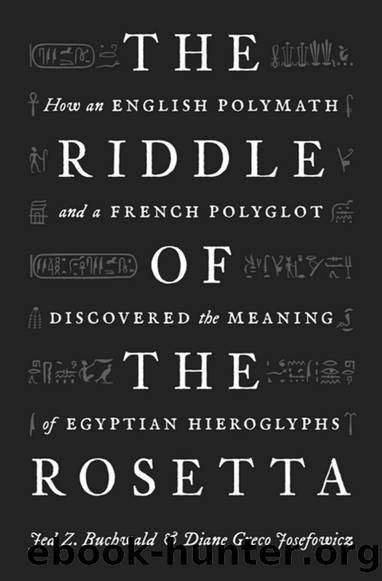The Riddle of the Rosetta by Jed Z. Buchwald

Author:Jed Z. Buchwald [Buchwald, Jed Z.]
Language: eng
Format: epub
ISBN: 9780691200910
Google: RdXXDwAAQBAJ
Goodreads: 54313278
Published: 2020-06-30T05:50:55+00:00
chap ter 20
A B A N D O N I NG
T H E A L PH A B E T AT
G R E N OB L E
Despite his extensive work on the Egyptian dictionary and grammar, Cham-
pollion seems to have done nothing of substance about the Egyptian (demotic)
text of the Rosetta inscription from 1808 until the autumn of 1814 when he had
sent the Royal Society a copy of his Pharaons.1 Some time thereafter Champol-
lion began working directly with the demotic. In a letter to Thévenet written
on July 18, 1816, while still in Figeac, Champollion asked him to send, from
Grenoble, a set of papers left behind in the exodus of the preceding year. These
papers comprised the engraving he had of the Rosetta âEgyptian and Greek
inscription,â as well as a poor copy of the Vetusta hieroglyphs, together with
his notes on demotic.2 When he returned to Grenoble in the autumn of 1816,
Champollion still lacked a copy of the superior Description engraving, which
had only recently been printed, based on the cast taken from the stone in
London by Jomard in 1815.3 If only he had a copy of the Descriptionâs plate,
Champollion lamented in a letter to his brother, he would be able âto place
beneath each hieroglyph the corresponding French word and even the Egyp-
tian cursive.â This work, he claimed, was âthree- fourths finishedâ despite the
lack of a clear and complete print. By June 1818, Champollion fi nally possessed
two good copies of the Rosetta inscriptions: one that Jollois, managing editor
of the Description, possessed and one of the Description plates.4
With this material at last available, Champollion began an extensive divi-
sion of the hieroglyphs into semantic equivalents, bracketed with what he took
to be the corresponding demotic, together with a list of putative alphabetic
signs for demotic that was clearly based on à kerbladâs work.5 It is likely that
he undertook the division in part because he had read Youngâs âinterpreta-
tionâ of the hieroglyphic text in the Archaeologia and was certain he could
do better. As he perfected an alphabet for the demotic via links to Coptic
equivalents, he produced a list of the meanings of specific words (fig. 20.1). 6
Download
This site does not store any files on its server. We only index and link to content provided by other sites. Please contact the content providers to delete copyright contents if any and email us, we'll remove relevant links or contents immediately.
The Daily Stoic by Holiday Ryan & Hanselman Stephen(3238)
The Fate of Rome: Climate, Disease, and the End of an Empire (The Princeton History of the Ancient World) by Kyle Harper(3007)
People of the Earth: An Introduction to World Prehistory by Dr. Brian Fagan & Nadia Durrani(2702)
Ancient Worlds by Michael Scott(2627)
Babylon's Ark by Lawrence Anthony(2622)
The Daily Stoic by Ryan Holiday & Stephen Hanselman(2466)
Foreign Devils on the Silk Road: The Search for the Lost Treasures of Central Asia by Peter Hopkirk(2434)
India's Ancient Past by R.S. Sharma(2417)
MOSES THE EGYPTIAN by Jan Assmann(2374)
The Complete Dead Sea Scrolls in English (7th Edition) (Penguin Classics) by Geza Vermes(2237)
Lost Technologies of Ancient Egypt by Christopher Dunn(2195)
The Earth Chronicles Handbook by Zecharia Sitchin(2180)
24 Hours in Ancient Rome by Philip Matyszak(2051)
Alexander the Great by Philip Freeman(2034)
Aztec by Gary Jennings(1977)
The Nine Waves of Creation by Carl Johan Calleman(1884)
Curse Tablets and Binding Spells from the Ancient World by Gager John G.;(1838)
Before Atlantis by Frank Joseph(1814)
Earthmare: The Lost Book of Wars by Cergat(1792)
